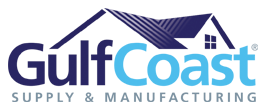 Installing properly weatherproofed metal roofing requires attention to a number of small but significant details. Here are four tips for assuring that every roof you install is efficiently and correctly weatherproofed.
Installing properly weatherproofed metal roofing requires attention to a number of small but significant details. Here are four tips for assuring that every roof you install is efficiently and correctly weatherproofed.
Using the Proper Sealant
“The first step in weatherproofing your roof is to use proper sealant in the right locations,” says Paul Hope, field service technician for Gulf Coast Supply.
Metal may be impervious to moisture on its own, but edges and contact points – such as where chimney flashing meets sidewall flashing – need to be sealed to prevent air or moisture from getting into the roof.
High-slope roofs rely heavily on gravity to channel water safely off the eaves, with each downhill panel placed beneath the panel above it. Low-slope roofs, on the other hand, require sealant between panels to protect against water infiltration. And aside from the degree of slope, other areas may also require sealant to keep rainwater at bay.
Caulk should be applied to chimney and sidewall flashing and anywhere a through-penetration occurs. Metal-on-metal contact points are never truly waterproof, so use caulk where metal panels meet other metal panels or flashing.
“You’re going to want to ensure that you create a large barrier of sealant wherever these two layers of metal meet,” Hope says.
When you need to achieve compression along Z trim, use butyl tape and fasteners. Install fasteners in the valleys of striated panels, not the peaks, to create uniform compression and reduce or eliminate metal warping.
Fastener selection
The choice of fasteners depends primarily on where they will be used.
“If you are placing your fastener in an exposed area that is going to see weather, you’re going to want a fastener designed for exposure to the elements,” Hope says.
In situations where the fastener will remain hidden, use pancake screws that will be protected by metal and sealant.
The low profile of pancake screws, when installed with caulk sealant where necessary, allows for a firm seal that will not cause dimpling in the adjoining metal panel. Dimples are essentially divots in the roof where water can pool and cause moisture infiltration over time.
As always, crews should take care not to under- or over-tighten screws. Under-tightened screws can leave empty space under or above the screw head, allowing moisture infiltration to take place. Over-tightened screws, on the other hand, will push washers out and away from the screw, negating their weatherproofing purpose.
Trim details and laps
Trim is the finishing touch installed along flashings and installed roof panels. It may seem aesthetic, but it serves an important purpose: preventing rainwater, wind and even pests from infiltrating the roof at joints and edges.
Extra attention to trim areas is a crucial step for a weatherproof roof.
Crews should increase lap coverage in areas such as in valleys, eaves, and sidewalls that channel a high volume of water off of the roof. Also, always check local building codes – having the correct lap coverage may make the difference between passing and failing a roof inspection.
Underlayment
Perhaps the most important element of a weatherproof roof is underlayment, which separates the wooden roof deck from the metal panels. Underlayment also provides an added level of waterproofing protection, but not all underlayment is created equal, according to Jared Pearce, technical services manager for Gulf Coast Supply.
“The first option we have in underlayment is 30-pound felt, which we’re all used to,” he says. “It has the shortest lifespan, but it is also your most cost effective.”
Synthetic underlayment, on the other hand, lasts longer because, unlike felt, it contains no organic ingredients.
The best underlayment option, Pearce says, is a peel-and-stick synthetic. It not only lasts longer than other options, it also chemically bonds to the roofing substrate. Always check local building codes to ensure proper installation.
Paying attention to these waterproofing details can help you achieve a well-installed roof that will protect your customers for years to come.
Contractors who have questions can reach out to us here at Gulf Coast Supply for additional information. Also – let us quote your next metal roof!
